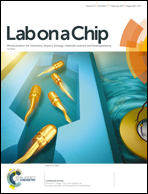Chromatin immunoprecipitation in microfluidic droplets: towards fast and cheap analyses†
Abstract
Genetic organization is governed by the interaction of DNA with histone proteins, and differential modifications of these proteins is a fundamental mechanism of gene regulation. Histone modifications are primarily studied through chromatin immunoprecipitation (ChIP) assays, however conventional ChIP procedures are time consuming, laborious and require a large number of cells. Here we report for the first time the development of ChIP in droplets based on a microfluidic platform combining nanoliter droplets, magnetic beads (MB) and magnetic tweezers (MT). The droplet approach enabled compartmentalization and improved mixing, while reducing the consumption of samples and reagents in an integrated workflow. Anti-histone antibodies grafted to MB were used as a solid support to capture and transfer the target chromatin from droplets to droplets in order to perform chromatin immunoprecipitation, washing, elution and purification of DNA. We designed a new ChIP protocol to investigate four different types of modified histones with known roles in gene activation or repression. We evaluated the performances of this new ChIP in droplet assay in comparison with conventional methods. The proposed technology dramatically reduces analytical time from a few days to 7 hours, simplifies the ChIP protocol and decreases the number of cells required by 100 fold while maintaining a high degree of sensitivity and specificity. Therefore this droplet-based ChIP assay represents a new, highly advantageous and convenient approach to epigenetic analyses.



 Please wait while we load your content...
Please wait while we load your content...